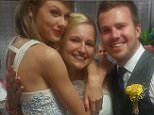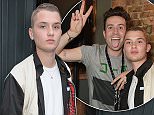Dear Bob Dylan, please come and sing in our field! How two cheeky British public schoolboys bamboozled rock's greatest stars to play at their very own Woodstock
Bob Dylan was getting angry. The trailer he’d been given as a changing room didn’t have a loo. His pregnant wife, Sara, had mentioned it, and, after he’d waited two hours while a problem with the sound on stage was fixed, pre-show nerves were making him uncomfortable. He now needed the toilet, too ...
Outside 200,000 fans, who’d trekked from all over Britain to witness the Second Coming of the then coolest man on the planet, were also getting noisily fractious at the delay.
This, therefore, was not the time for Dylan to be told that the only place for artists to relieve themselves was somewhere out in the dark across the field. In his newly pressed, crisp white stage suit, he didn’t like the sound of that.


George Harrison and Bob Dylan enjoyed a game of tennis while on the Isle of Wight for the 1969 festival

Dylan, pictured, took to the stage wearing a white suit while desperately needing to go to the toilet
In the end, he couldn’t wait any longer. Getting up, he relieved himself out of the window of the trailer, and then triumphantly took the stage at the Isle of Wight Festival of Music.
That night, August 31, 1969, is now on nerdy lists as one of the most epoch-making rock music nights ever. Was it? Well, I was there, and in some ways it was. But not because of the 17 songs Dylan sang.
The fact that he was there at all, resurrected, as it were, from his three years of self-imposed isolation following a motorcycle accident, was what made it special, and what had acted as a magnet, not only to his fans, but also to British rock aristocracy.
There they all were paying homage just below the stage: a couple of Rolling Stones, two Pink Floyds, Eric Clapton, Elton John, Stevie Winwood. Then there were three Beatles — John Lennon and Yoko Ono, George and Pattie Harrison, and Ringo Starr and his first wife Maureen, along with Elizabeth Taylor, Jane Fonda, her husband, film director Roger Vadim, songwriter Lionel Bart and other assorted celebs of the time.
Some of them had blankets wrapped around them, which was understandable because it was freezing cold.
Today, when we think of rock festivals, we envisage high-tech, digitised Glastonbury events, where everything is televised, where thousands of mobile phones twinkle in the blackness, and where the performers are cosseted in state-of-the-art, en-suite trailers.
But, back then, rock festivals were in their infancy, and the midwives to this one were two young brothers on the Isle Of Wight called Foulk who’d had a crazy idea.
Which was: why don’t we invite the biggest and most elusive singer-songwriter in the world to be the headline act at a rock festival on an island off the south coast of England of which he’s probably never heard?
The fact that they did invite him, and that he came, is what made that moment in August 1969 special.
It really was a crazy idea. Why would any New York manager even bother replying to the organisers, two young brothers in their early 20s? How could these boys ever get such a vast undertaking together? And whoever heard of anything big, new or exciting happening on the sleepy, genteel island?

This amazing image has John Lennon, Yoko Ono, George Harrison and Ringo Starr waiting for Bob Dylan
The Foulk brothers themselves, Ronnie, aged 24, and Ray, 23, didn’t know the answers to any of these questions, nor dozens more they asked themselves daily — not least where, exactly, they were going to find the money to even begin their venture?
But, with the innocence of youth, they pursued their dream, discovered the name and address of Dylan’s manager in a hippie newspaper, and wrote their pitch. They may not have been sharp-elbowed music businessmen, but they had one great thing going for them. Timing.
It was the end of the Sixties, and they were both imbued with the boundless, youthful optimism of that time which said that anything was possible for those who tried — even if you lived in the back of beyond.
The story of how they achieved their dream has now been told by Ray Foulk in a memoir of get-up-and-go enterprise. Whatever the brothers lacked in experience, they made up for in energy — and maybe a little cheek, too.
Having both left their fee-paying boarding school in 1961 without an O-level between them, and been put to work — Ronnie in an estate agency, and Ray as an apprentice printer — six years later Ray had a little print firm, a wife and twin daughters.
And, as both chairman and secretary of the West Wight CND since his teens, he knew about organising events — albeit only jumble sales and dances. Nevertheless, it had been useful experience, and by 1968 he and his brother were ready for bigger things.
Neither of them knew much about pop music, but slowly the idea of organising a little pop happening began to take shape.

Ronnie Foulk, left, with his brother invited Bob Dylan, centre, to play the Isle of Wight
So, convincing a farmer to mow a field of barley — the stubble would later prove painful to the bottoms of the festival-goers — and rent them the space, by August 1968 they’d put together their trial run of a festival.
With Jefferson Airplane, Fairport Convention and the Crazy World of Arthur Brown on the bill and ten thousand fans, even that was impressive for what turned out to be a rehearsal — although, as some ticket agencies didn’t pay them, it lost money.
Dylan, a year later, would be the real thing. Hardly expecting a response from his management, they were astonished when they weren’t rejected out of hand. Call us in another month, they were told.
They did. Without having any money yet, but, making it up as they went along, they offered the great man an all-expenses-paid trip on the maiden voyage of the QE2, a limousine, a manor house to stay in, a chauffeur, a cook and a governess for the Dylan children.
Bob wants to know more, came the reply. So, fibbing about their youth by adding two years to their ages, they printed a whole brochure, displaying the delights of visits to Queen Victoria’s Osborne House, and mentioning some of the British groups who had agreed to be at the festival — The Who, Joe Cocker, the Moody Blues.
Finally came the crunch. Money. Bob would come, but he wanted his musicians, The Band, to be with him as well as singer-guitarist Richie Havens. In all, that would cost $87,000 — in today’s money around £470,000. Furthermore, Bob wanted to meet Ray Foulk in New York — with his American lawyer.

Elton John, pictured, was one of the many stars to appear on the Island for the festival
Foulk didn’t even have an English lawyer, not one who knew the vagaries of music showbiz, anyway.
But even worse than that: he didn’t have a passport. He’d never been abroad. Yet, somehow, by working the phones and his friends, he got both within three days, the local bobby countersigning his photograph to take to the Passport Office in London.
As for Dylan, he was as pleasant and quiet at the meeting as could be imagined. The only nervous moment came when his manager suggested to Foulk that it was ‘time for little pot’ and offered him a joint. Ray may have been about to put on Britain’s biggest rock festival yet, and he may have been 23 in 1969, but he was from the Isle of Wight, and he had never encountered drugs. He said: ‘No thank you.’
They’d already rented the festival site near Wootton Bridge, so, back on the island, all Ray and Ronnie Foulk had to do was to find the money, arrange the building of the stage, the hiring of the sound system, the fencing around the arena, the lights, the phone wires, the buses to ferry the fans to and fro, the lavatories, the food concessions, the security, the insurance, the St John Ambulance people, and a hundred other things. The design of the tickets and the advertising they left to their younger brother Bill and his enthusiastic friends from the Royal College of Art.
Throwing themselves into the spirit of the project, they came up with a motif of a King Kong gorilla with fairy wings on what looked like a psychedelic juke box with female bosoms. Well, it was the Sixties!
At the end of the day, ticket sales would pay for Dylan and the other acts, but until the ticket agencies paid up, immediate investment had to be acquired to build the festival site.
The company printing the programmes decided to invest, as did the rich next-door neighbour, their mother and some friends. With the first man landing on the Moon in July, and the murders of starlet Sharon Tate and company in mid-August, the summer of 1969 was an incident-filled time.
But the Foulks could have been forgiven if the only news story that was gathering their full attention was the U.S. rock festival at Woodstock (near where Dylan lived), just two weeks before their own extravaganza.
The Woodstock organisers had secretly hoped that Dylan would suddenly turn up there. The Brothers Foulk had feared it. But by ignoring Woodstock in favour of Wootton Bridge, Dylan did what he most liked to do — the unpredictable. It also meant he didn’t get wet — Woodstock is remembered for torrential rain and mud. Although it was a bit nippy on the Isle of Wight, the rain kept off.
Not everything went according to plan, of course. The Dylans missed the maiden voyage of the QE2 and had to fly from New York, the grand house they’d been promised became unavailable so that they stayed at a more modest but homely cottage-type farmhouse. Nor did a top chef materialise for them, so they were fed on porridge, pies and plum crumbles.
They didn’t complain. On the contrary they seemed very happy, with Foulk catching a rare moment when he found Dylan and George Harrison sitting together with their acoustic guitars and playing the Everly Brothers’ hit All I Have To Do Is Dream.
Watching Dylan and John Lennon taking on Harrison and Ringo Starr in a game of doubles tennis must have been something to see, too.
Meanwhile, all roads led to Wootton Bridge as the Isle of Wight ferries and hovercrafts disgorged thousands upon thousands of fans, their sleeping bags and tents on their backs, some with bands around their heads, as they’d seen in the TV news from Woodstock. In those days before there were huge screens at festivals, most fans would have been too distant to see anything more than a tiny speck of a guy in a white suit on a distant stage.
But that wasn’t the point to the fans. What was important was that they were there with their friends on the night Bob Dylan made his comeback on the Isle of Wight.
The show ended after 11pm. And, as Dylan left the stage, fences were pulled down and free souvenir copies of the Evening Standard, which I’d helped write earlier that week, were used as kindling as little bonfires were lit.
The Foulk brothers didn’t get rich —but they didn’t lose money either. They did something better than that. They had the craziest dream and they made it come true.
- Stealing Dylan From Woodstock by Ray Foulk (with Caroline Foulk) is published by Medina at £22.95.
-
 Unlikely hero causes chaos with INSANE dance off routine
Unlikely hero causes chaos with INSANE dance off routine
-
 Moment NAACP leader is confronted about her white parents
Moment NAACP leader is confronted about her white parents
-
 Rachel Dolezal's parents speak out about her ethnicity...
Rachel Dolezal's parents speak out about her ethnicity...
-
 Courtney Barnes gives a very flamboyant retelling of car...
Courtney Barnes gives a very flamboyant retelling of car...
-
 Rachel Dolezal doesn't 'give two s***s' what anyone thinks
Rachel Dolezal doesn't 'give two s***s' what anyone thinks
-
 Rachel Dolezal lectures students on history of black...
Rachel Dolezal lectures students on history of black...
-
 Horrifying moment coach mows down athletes at European Games
Horrifying moment coach mows down athletes at European Games
-
 Prince George waves to crowd from Buckingham Palace balcony
Prince George waves to crowd from Buckingham Palace balcony
-
 Day care worker caught on camera 'roughing up' toddler
Day care worker caught on camera 'roughing up' toddler
-
 Driver crashes rented Lamborghini on Dallas highway
Driver crashes rented Lamborghini on Dallas highway
-
 Rachel Dolezal resents rich white men on US currency
Rachel Dolezal resents rich white men on US currency
-
 Female NY prison worker pleads not guilty in convict escape
Female NY prison worker pleads not guilty in convict escape
-
 It's called a 'ring finger' for a reason! Sweden's Prince...
It's called a 'ring finger' for a reason! Sweden's Prince...
-
 All eyes on gorgeous George! Prince steals the show with...
All eyes on gorgeous George! Prince steals the show with...
-
 'She doesn't want to be seen with us because we'll ruin her...
'She doesn't want to be seen with us because we'll ruin her...
-
 Lord of the Dance! Unassuming teenager proves looks CAN be...
Lord of the Dance! Unassuming teenager proves looks CAN be...
-
 PHOTO EXCLUSIVE: ‘I consider myself to be black and I don’t...
PHOTO EXCLUSIVE: ‘I consider myself to be black and I don’t...
-
 Police sniper shoots dead gunman who opened fire on Dallas...
Police sniper shoots dead gunman who opened fire on Dallas...
-
 EXCLUSIVE: Hundreds of fuming United Airlines passengers...
EXCLUSIVE: Hundreds of fuming United Airlines passengers...
-
 Snap! How Prince George appeared in the very same romper...
Snap! How Prince George appeared in the very same romper...
-
 Millionaire Hillary launches campaign do-over with 'slightly...
Millionaire Hillary launches campaign do-over with 'slightly...
-
 'Don't blow my cover': How NAACP leader told her adopted...
'Don't blow my cover': How NAACP leader told her adopted...
-
 Intercepted by ISIS fanatics just yards from safety: Moment...
Intercepted by ISIS fanatics just yards from safety: Moment...
-
 'Iggy Azalea ran so Rachel Dolezal could fly': Twitter goes...
'Iggy Azalea ran so Rachel Dolezal could fly': Twitter goes...













































































































































































































































